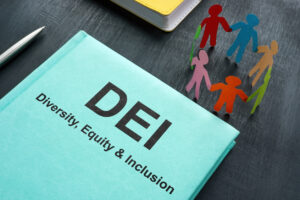The Scoop: TikTok ramps up social pressure ahead of looming U.S. ban
Also: FCC chair sends ‘end DEI’ message to companies; Block CEO Dorsey catches heat for insensitive layoff email.

TikTok is ramping up its efforts to avoid a U.S. ban as the April 5 deadline approaches for its forced sale to a non-Chinese owner such as Oracle.
With legal challenges mounting and the threat of a ban growing more real, the platform is taking a new approach by launching an extensive advertising campaign aimed at bolstering its public image. The campaign, which includes TV spots, social media ads and print advertisements in major newspapers, highlights personal stories such as a woman who found a kidney donor through TikTok and emphasizes the platform’s role in supporting small businesses.
TikTok has already spent over $7 million on advertising in February and March, surpassing its $5 million spend during the same period last year, according to the New York Times.
But TikTok isn’t just relying on traditional advertising; the company is also increasing its presence in Washington, D.C., in an attempt to influence lawmakers and sway public sentiment.
TikTok is “trying to raise public sentiment in favor of the company,” said Lindsay Gorman, managing director of the technology program at the German Marshall Fund and a tech adviser under the Biden administration.
“TikTok is essentially trying to re-litigate the law and encouraging Congress to backtrack on calls to enforce it.”
Why it matters: TikTok’s new approach marks a shift from its earlier focus on legal tactics to a more grassroots campaign aimed at influencing both public opinion and lawmakers.
By framing itself as a platform that has positively impacted people’s lives, TikTok hopes to avoid alienating users who may not be following every legal development. The company knows that public sentiment could be the key to its survival, but it also faces a delicate balancing act.
While it is vital for TikTok to mobilize users in its defense, it is equally important that the company doesn’t scare its core audience. In previous efforts to combat the threat of a ban, TikTok users had already shown signs of anxiety, with many deleting the app when they feared it might be banned.
“It’s a total 180,” H. Lee Justine, a TikTok creator and author, told the Times. “Back in January, if you were on the app, you were hearing about the ban every single day. It’s not even on my For You Page now — no one’s chattering about it.”
TikTok needs to reassure casual users that the app is not going anywhere and that it is still a viable platform for entertainment, business, and personal connection.
TikTok is carefully crafting its message to highlight its value, rather than focusing solely on the risks of a ban. By emphasizing the real-world impact TikTok has on users’ lives – whether by connecting individuals with life-saving resources or supporting small businesses – it makes a more emotional appeal.
As the saying goes, there’s power in the people.
Editor’s Top Reads
- The Atlantic revealed that Defense Secretary Pete Hegseth shared sensitive airstrike plans for Yemen in a Signal group chat, mistakenly including the publication’s editor-in-chief, Jeffrey Goldberg. The error, along with potential security violations, such as using unsecured platforms and personal phones, raises serious concerns. Some messages, set to disappear after a week, may have bypassed federal archiving requirements, according to the New York Times. Despite these issues, many conservatives and right-leaning media outlets are downplaying the situation. White House Press Secretary Karoline Leavitt attempted to discredit Goldberg as a “Trump-hater,” which Fox News reported and many of President Donald Trump’s supporters agreed with on X. It’s clear that no matter what Trump says or does, his supporters will follow.
- Block CEO Jack Dorsey announced layoffs affecting 931 employees, around 8% of the fintech company, via an internal email, later leaked to TechCrunch. In his matter-of-fact email to staff, Dorsey, the founder of Twitter, breaks down the cuts, including efforts to “flatten Block’s hierarchy.” Dorsey also noted that Block reassigned 193 managers to individual contributor roles. Dorsey insisted the layoffs were not financially motivated, stating, “None of the above points are trying to hit a specific financial target, replacing folks with AI or changing our headcount cap.” Instead, he framed them as necessary for efficiency, saying, “We’re behind in our actions, and that’s not fair to the individuals who work here or the company.” Dorsey’s statement is concise and strategic, ensuring clarity on the company’s rationale. But his message lacks emotional depth. His note to departing employees – “I am grateful and appreciative for you and your work, which has built us up to this point” – feels transactional rather than compassionate. And many people claiming to be employees are commenting as much on the TechCrunch story. “I was laid off. At 4:15pm in my timeline. Given 45 minutes and a ‘today’s your last day, see ya’ email. My whole department was too – sales enablement and sales training all wiped. The email is cold, and the actions were heartless,” user Michelle K wrote. PR professionals must remember that corporate messaging will be publicly scrutinized, requiring a balance between transparency and empathy.
- The Trump administration is using federal merger approvals as leverage to push companies to abandon DEI policies. Brendan Carr, chairman of the Federal Communications Commission, insinuated the agency would block media mergers involving companies that promote DEI, arguing such policies don’t serve the “public interest.” “Any businesses that are looking for FCC approval, I would encourage them to get busy ending any sort of their invidious forms of DEI discrimination,” the Trump appointee said in an interview with Bloomberg. This marks a shift from traditional merger reviews, which typically focus on competition and consumer impact. Legal experts note that federal regulators have never before used HR policies as grounds for blocking mergers, per CNN. Carr’s stance creates uncertainty for businesses, as the administration hasn’t defined what constitutes “illegal DEI.” That’s creating a level of uncertainty, causing confusion for companies that want to avoid potential legal run-ins. “This creates a substantial chilling effect because companies don’t know what is or isn’t legal from the administration’s perspective,” Aaron Goldstein, an attorney at Dorsey & Whitney, told CNN. Companies need to be mindful that the Trump administration’s stance remains unclear, meaning merely rebranding programs may not be enough to avoid scrutiny. It’s vital that companies are very intentional with how they handle anything related to diversity and inclusion.
Casey Weldon is a reporter for PR Daily. Follow him on LinkedIn.







